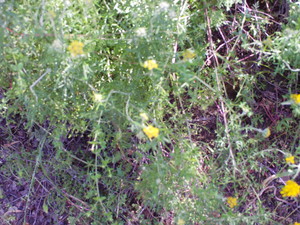Ovarian cysts are often asymptomatic. The cyst may be follicular, corpus luteum, or dermoid. Endometriosis or malignancy may be involved. They may become polycystic, where follicular cysts develop with pituitary overproduction of luteinizing hormone (which initiates ovulation). Related pain may be caused by a number of factors related to the cysts:
— Aching and heaviness may be caused by the pressure of the cyst mass;
— Sudden or sharp pain might indicate a rupture, hemorrhage or torsion;
— Fever, leukocytosis and signs of shock may accompany the above;
— Hemorrhage into a cyst is common and can produce pain;
— Cases of follicular or corpus luteum cysts which can have thin walls, which can bleed;
— Corpus lutein cysts with thicker walls (will rarely rupture);
— A twisted overaian cyst can cause intermittent colicky pain;
— A ruptured dermoid cyst and perforated enometioma;
— Uterus malposition can cause pelvic pain in the presence of scar tissue and fixed by adhesion;
— An invasive neoplasm can also cause pain resulting from an invasion at the pelvic nerve roots.
In the case of a contorted, twisted cyst, surgical removal is usually undertaken, which might risk embolism. Further testing for neoplasm could include fine-needle aspiration, to withdraw ovarian tissue for cytopathology.
Borderline Epithelial Tumors
There are a number of ovarian tumors, mostly of epithelial origin, that have been designated as borderline, which can be specifically referred to atypical proliferating or low malignant potential. There are several types of these epithelial borderline tumors, which are often not easily diagnosed. Serous tumors can appear to be fallopian tube epithelium and can resemble cysts. Mucinous tumors can appear to be endocervix mucosa. Endometroid tumors can appear to be endometrium glands. Clear cell tumors can present as enlarged endometrial glands.
These borderline tumors can stratify and can project into grapelike clusters. Serous tumors can grow very large, pressing against the fallopian tube or nearby peritoneum. Should the invasion multiply out of the focal point of origin it can be considered malignant. Surgical cure is likely when the tumor is confined to the ovaries. Ovarian cancer affects about 1 in 70 women in US. It has been known as the silent disease because it produces little symptoms until later stages.
Possible Causes
A number of modern chemicals, which disrupt hormones and encourage mutagenic response within ovarian cells may be at the root of ovarian cysts. Products known to encourage mutagenic behavior and disrupt healthy hormone activity include:
— Pesticides and preservatives;
— Toxic household cleaners;
— Plastics with monomer plasticizers and flex factors such as BPA;
— Copper or aluminum pans; 5) Chlorine (pools, bleach);
— Fluorine or fluoride (tap water and toothpaste);
— Mercury (amalgrams, medication preservatives, etc.);
— Lead (paints, pipes).
Oxidative Stress/Low Glutathione levels
Glutathion is a tripeptide, which the body produces from cystein, glutamic acid and glycine. It can be released by the liver into the bloodstream, where it acts as a scavenger of free radicals, especially oxygen free radicals and hydrogen peroxide produced by superoxide, reducing cell injury by oxidation. Glutathion will react as glutathione peroxidase to reduce peroxides and oxygen radicals to catalase and water. Glutathione also assists leucocytes in their reduction of free radicals and bacteria lyses. It is also a component of carbohydrate metabolism. Low glutathione levels are associated with high levels of infection and immunodeficiency. Nerve damage, brain lesions, an increased pathways for tumor growth. Low glutathione levels go hand in hand with oxidative stress, because the oxidized radicals are not properly reduced with glutathione.
The best way to boost glutathione levels is by consuming vitamin C through foods and supplements, and consuming foods containing glutathione. These include raw avocado, tomatoes, walnuts, spinach, carrots, grapefruit and asparagus.
Mineral balancing
Many women have a reduced ability to bind copper. This can result in copper toxicity and bio-unavailability. This can be a possible contributing relationship with ovarian cysts. Copper is also an integral part of the oxidation reduction process. This means adding sources of trace and macro minerals to our diet can balance copper levels. Good sources include mineral water, whole (unprocessed) rock salt, greenfoods, clay supplements and others.
Herbal Prevention Strategies
A number of natural herbs have been recommended in traditional therapies for the prevention of ovarian cysts. While there has been little research confirming their success, clinical use and anecdotal experience has been passed down through generations of herbalists:
(Please consult your health professional regarding dosages and potential contraindications before using.)
— Mitchella repens (Partridge Berry) may improve pelvic circulation, which can reduce congestion and irritation.
— Diosorea villosa (Wild Yam) has also been used by herbalists to relieve ovarian pain.
— The following combination has been used by herbalists to strengthen uterine and fallopian cell walls: Caulophyllum thalicitroids (Blue Cohosh), Chamaelirium luteum (False Unicorn Root), Leonurus cardiaca (Motherwort) and Achillea millefolium (Yarrow).
–These herbs are considered by herbalists to be antimutagenic: Uno De Gato, Pau D arco, Bloodroot, Burdock, Ginger, Turmeric, Parsley, Red Clover.
–Mushroom therapy from Traditional Chinese Medicine has included Maitake, Shiitake and Reishi extracts. Many studies have shown that these mushrooms extend cancer survival rates when taken adjunctively with cancer therapy.
Preventative Foods
A study sponsored by the American Cancer society showed that women who drank skim or reduced fat milk were three times less likely to develop ovarian cancer than those that either didn’t drink milk or drank full fat milk. Potassium may be the key, as a cup of milk supplies 400 mg of potassium. However, milk has a number of other components such as CLA, vitamin D, amino acids, etc.
Alkaline, mineral-rich foods are suggested. Mineral-rich foods include apricots, apples, almonds, artichokes, avocado, banana, lima beans, beets, beet greens, berries, Brussels sprouts, carrots, casaba, cauliflower, celery, goat cheese, swiss cheese, coconuts, corn, cranberries, cucumbers, dandelion greens, eggplant, grapes, honey, kale, citrus, lettuce, mango, mushrooms, oats, okra, onions, papaya, parsnips, parsley, peas, pineapple, potato, radishes, raisins, spinach, chard, tomatoes, turnips, walnuts, watermelon, watercress, whey, zucchini. Foods that are high in tocopherols, antherocyans, sterols, sitosterols, flavonoids, carotinoids, phytosterols are recommended. A focus on foods with colors, green, yellow, orange, red, etc for flavonoids and carotinoids. These include onions, carrots, celery, broccoli, spinach, green peppers, squash, beets, berries, cranberries, canteloup, apples, apricots, etc. Anticancer foods include broccoli with sulforaphanes, indoles and isothiocyanates, tomatoes with lycopene and chlorogenic acid, and 10,000 other phytochemicals, onions and garlic with allylic sulfides, almonds with laetrile, soy and beans with genistein and saponins, spinach and kale with lutein and zeaxanthin, etc. To maximize effects of certain vegetables, juices are suggested. Juices of celery, spinach, beet and carrot are excellent alkalizing juices. Sugar and processed foods should be reduced. High fiber, whole grains should be eaten, fiber should be 30-40 grams per day. Beans and soy with isoflavones. Raw or ground flaxseeds are a source of lignans, which modulate estrogen levels and is known to limit tumor growth.
Vitamins/Minerals for preventive consideration
— Vitamin C will help reduce copper toxicity.
— Rutin also lowers serum copper.
— Zinc balances copper, and zinc deficiency can lead to excessive copper.
— Calcium chelate or calcium disodium edentate also can draw copper out of the body.
— Flaxseed oil and primrose oil nourish cell membranes and reduce inflammation.
— Selenium has been shown to have cancer prevention properties.
— Food-based multivitamins are helpful to increase circulating antioxidants.
— Kelp and spirulina supply phytonutrients, minerals and other important nutrients.
Massage with Essential Oils
A traditional prevention strategy used for many centuries is castor bean oil packs. A pack of warm caster oil can be placed on the abdomen at night before retiring. Massages of the lower back and abdomen with castor bean oil should be light, slow and gentle. A drop or two of melissa (lemon balm) oil, peppermint oil or rosemary oil may be added to the massage oil or pack for additional benefit.
Other Lifestyle Choices
Adequate sleep is critical. Deep breathing to increases flow of oxygen into the body. 70-80 oz water per day is essential. Daily exercise increases circulation and detoxifies. Aerobic exercise has been associated with lowered reproductive cancers in women. Sunshine exposure and outdoor activity are also important. A number of studies have shown that moderate sunbathing can help prevent cancer.
This information is for research purposes only. Be sure to consult your health professional if you suspect you have this or any other disease, and before making any significant changes to your diet, lifestyle or supplements.




